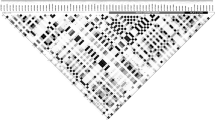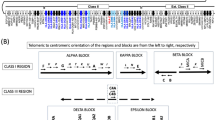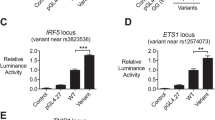Abstract
Tumor necrosis factor (TNF) and lymphotoxin alpha (LTA) influence a variety of cellular responses and play a complex role in the immune response. Several single nucleotide polymorphisms (SNPs) have been reported in these major histocompatibility complex (MHC)-linked loci; however, a comprehensive examination of polymorphisms in the promoter regions of TNF and LTA has not been carried out and was undertaken here. Seven novel SNPs in LTA were identified by sequence analysis of 69 samples. Eight novel TNF alleles and 16 novel LTA alleles were designated. The TNF alleles clustered into two closely related groups, while the LTA alleles clustered into three distinct groups using phylogenetic and percentage difference analyses. A total of 52 unique TNF-LTA-HLA haplotypes are reported. There appear to be some associations between TNF/LTA alleles and HLA haplotypes, but not with specific HLA alleles. The majority of the SNPs appear to be randomly associated within and between the two loci except for the LTA SNPs at −293, +81 and +369. These observations may provide an explanation for the oftentimes contradictory results of studies associating individual cytokine gene SNPs with expression level phenotypes, HLA and disease.
This is a preview of subscription content, access via your institution
Access options
Subscribe to this journal
Receive 6 digital issues and online access to articles
$119.00 per year
only $19.83 per issue
Buy this article
- Purchase on Springer Link
- Instant access to full article PDF
Prices may be subject to local taxes which are calculated during checkout



Similar content being viewed by others
References
Vassalli P . The pathophysiology of tumor necrosis factors. Ann Rev Immunol 1992; 10: 411–452.
Ware CF, VanArsdale TL, Crowe PD, Browning JL . The ligands and receptors of the lymphotoxin system. Curr Top Microbiol Immunol 1995; 198: 175–218.
Carswell EA, Old LJ, Kassel RL, Green S, Fiore N, Williamson B . An endotoxin-induced serum factor that causes necrosis of tumors. Proc Natl Acad Sci USA 1975; 72: 3666–3670.
Schoenfeld HJ, Poeschl B, Frey JR et al. Efficient purification of recombinant human tumor necrosis factor beta from Escherichia coli yields biologically active protein with a trimeric structure that binds to both tumor necrosis factor receptors. J Biol Chem 1991; 266: 3863–3869.
Sacca R, Kratz A, Campos-Neto A, Hanson MS, Ruddle NH . Lymphotoxin: from chronic inflammation to lymphoid organs. J Inflam 1996; 47: 81–84.
Sedgwick JD, Riminton DS, Cyster JG, Korner H . Tumor necrosis factor: a master-regulator of leukocyte movement. Immunol Today 2000; 21: 110–113.
Allen RD . The new genetics of bone marrow transplantation. Genes Immun 2000; 1: 316–320.
Broudy VC, Harlan JM, Adamson JW . Disparate effects of tumor necrosis factor-alpha/cachectin and tumor necrosis factor-beta/lymphotoxin on hematopoietic growth factor production and neutrophil adhesion molecule expression by cultured human endothelial cells. J Immunol 1987; 138: 4298–4302.
Sacca R, Cuff CA, Lesslauer W, Ruddle NH . Differential activities of secreted lymphotoxin-α3 and membrane lymphotoxin-α1β2 in lymphotoxin-induced inflammation: critical role of TNF receptor 1 signaling. J Immunol 1998; 160: 485–491.
Nedospasov SA, Shakhov AN, Turetskaya RL et al. Tandem arrangement of genes coding for tumor necrosis factor (TNF-alpha) and lymphotoxin (TNF-beta) in the human genome. Cold Spring Harb Symp Quant Biol 1986; 51 (Part 1): 611–624.
Nedwin GE, Jarrett-Nedwin J, Smith DH et al. Structure and chromosomal localization of the human lymphotoxin gene. J Cell Biochem 1985; 29: 171–181.
English BK, Weaver WM, Wilson CB . Differential regulation of lymphotoxin and tumor necrosis factor genes in human T lymphocytes. J Biol Chem 1991; 266: 7108–7113.
Rhoades KL, Golub SH, Economou JS . The regulation of the human tumor necrosis factor α promoter region in macrophage, T cell, and B cell lines. J Biol Chem 1992; 267: 22102–22107.
Tsai EY, Yie J, Thanos D, Goldfeld AE . Cell-type-specific regulation of the human tumor necrosis factor alpha gene in B cells and T cells by NFATp and ATF-2/jun. Mol Cell Biol 1996; 16: 5232–5244.
D'Alfonso S, Richiardi PM . An intragenic polymorphism in the human tumor necrosis factor alpha (TNFA) chain-encoding gene. Immunogenetics 1996; 44: 321–322.
D'Alfonso S, Richiardi PM . A polymorphic variation in a putative regulation box of the TNFA promoter region. Immunogenetics 1994; 39: 150–154.
Uglialoro AM, Turbay D, Pesavento PA et al. Identification of three new single nucleotide polymorphisms in the human tumor necrosis factor-α gene promoter. Tissue Antigens 1998; 52: 359–367.
Richardson A, Sisay-Joof F, Ackerman H et al. Nucleotide diversity of the TNF gene region in an African village. Genes Immun 2001; 2: 343–348.
Higuchi T, Seki N, Kamizono S et al. Polymorphism of the 5′-flanking region of the human tumor necrosis factor (TNF)-α gene in Japanese. Tissue Antigens 1998; 51: 605–612.
Brinkman BM, Kaijzel EL, Huizinga TW, Giphart MJ, Breedveld FC, Verweij CL . Detection of a C-insertion polymorphism within the human tumor necrosis factor alpha (TNFA) gene. Hum Genet 1995; 96: 493.
Pennica D, Nedwin GE, Hayflick JS et al. Human tumor necrosis factor: precursor structure, expression and homology to lymphotoxin. Nature 1984; 312: 724–729.
Nedwin GE, Naylor SL, Sakaguchi AY et al. Human lymphotoxin and tumor necrosis factor genes: structure, homology and chromosomal localization. Nucleic Acids Res 1985; 13: 6361–6373.
Messer G, Spengler U, Jung MC et al. Polymorphic structure of the tumor necrosis factor (TNF) locus: an NcoI polymorphism in the first intron of the human TNF-β gene correlates with a variant amino acid in position 26 and a reduced level of TNF-β production. J Exp Med 1991; 173: 209–219.
Dawkins RL, Leaver A, Cameron PU, Martin E, Kay PH, Christiansen FT . Some disease-associated ancestral haplotypes carry a polymorphism of TNF. Hum Immunol 1989; 26: 91–97.
Abraham LJ, Du DC, Zahedi K, Dawkins RL, Whitehead AS . Haplotypic polymorphisms of the TNFB gene. Immunogenetics 1991; 33: 50–53.
Ferencik S, Lindemann M, Horsthemke B, Grosse-Wilde H . A new restriction fragment length polymorphism of the human TNF-B gene detected by AspHI digest. Eur J Immunogenet 1992; 19: 425–430.
Knight JC, Keating BJ, Rockett KA, Kwiatkowski DP . In vivo characterization of regulatory polymorphisms by allele-specific quantification of RNA polymerase loading. Nat Genet 2003; 33: 469–475.
Ozaki K, Ohnishi Y, Iida A et al. Functional SNPs in the lymphotoxin-α gene that are associated with susceptibility to myocardial infarction. Nat Genet 2002; 32: 650–654.
Nedospasov SA, Udalova IA, Kuprash DV, Turetskaya RL . DNA sequence polymorphism at the human tumor necrosis factor (TNF) locus: numerous TNF/lymphotoxin alleles tagged by two closely linked microsatellites in the upstream region of the lymphotoxin (TNF-β) gene. J Immunol 1991; 147: 1053–1059.
Abraham LJ, Kroeger KM . Impact of the −308 TNF promoter polymorphism on the transcriptional regulation of the TNF gene: relevance to disease. J Leukoc Biol 1999; 66: 562–566.
Udalova IA, Richardson A, Denys A et al. Functional consequences of a polymorphism affecting NF-kappaB p50-p50 binding to the TNF promoter region. Mol Cell Biol 2000; 20: 9113–9119.
Skoog T, van't Hooft FM, Kallin B et al. A common functional polymorphism (C–>A substitution at position −863) in the promoter region of the tumour necrosis factor-alpha (TNF-alpha) gene associated with reduced circulating levels of TNF-alpha. Hum Mol Genet 1999; 8: 1443–1449.
Hohjoh H, Tokunaga K . Allele-specific binding of the ubiquitous transcription factor OCT-1 to the functional single nucleotide polymorphism (SNP) sites in the tumor necrosis factor-alpha (TNFA) promoter. Genes Immun 2001; 2: 105–109.
van Heel DA, Udalova IA, De Silva AP et al. Inflammatory bowel disease is associated with a TNF polymorphism that affects an interaction between the OCT1 and NF(-kappa)B transcription factors. Hum Mol Genet 2002; 11: 1281–1289.
Knight JC, Udalova I, Hill AV et al. A polymorphism that affects OCT-1 binding to the TNF promoter region is associated with severe malaria. Nat Genet 1999; 22: 145–150.
Mycko M, Kowalski W, Kwinkowski M et al. Multiple sclerosis: the frequency of allelic forms of tumor necrosis factor and lymphotoxin-alpha. J Neuroimmunol 1998; 84: 198–206.
Abraham LJ, French MAH, Dawkins RL . Polymorphic MHC ancestral haplotypes affect the activity of tumor necrosis factor-alpha. Clin Exp Immunol 1993; 92: 14–18.
Stüber F, Petersen M, Bokelmann F, Schade U . A genomic polymorphism within the tumor necrosis factor locus influences plasma tumor necrosis factor-α concentrations and outcome of patients with severe sepsis. Crit Care Med 1996; 24: 381–384.
Whichelow CE, Meager AJ, Hitman GA, Sachs JA . The TNFβ 10.5 kb genotype is associated with low levels of TNF diminished secretion of TNFβ by PHA activated PBLs from IDDM patients. Diabetes Res Clin Pract 1991; 14: S22.
Heesen M, Kunz D, Bachmann-Mennenga B, Merk HF, Bloemeke B . Linkage disequilibrium between tumor necrosis factor (TNF)-alpha−308 G/A promoter and TNF-beta NcoI polymorphisms: association with TNF- alpha response of granulocytes to endotoxin stimulation. Crit Care Med 2003; 31: 211–214.
Bidwell J, Keen L, Gallagher G et al. Cytokine gene polymorphism in human disease: on-line databases. Genes Immun 1999; 1: 3–19.
Haukim N, Bidwell JL, Smith AJP et al. Cytokine gene polymorphism in human disease: on-line databases, Supplement 2. Genes Immun 2002; 3: 313–330.
Probert L, Selmaj K . TNF and related molecules: trends in neuroscience and clinical applications. J Neuroimmunol 1997; 72: 113–117.
Matsuyama T, Kobayashi N, Yamamoto N . Cytokines and HIV infection: is AIDS a tumor necrosis factor disease? AIDS 1991; 5: 1405–1417.
McGuire W, Hill AVS, Allsopp CEM, Greenwood BM, Kwiatkowski D . Variation in the TNF-α promoter region associated with susceptibility to cerebral malaria. Nature 1994; 371: 508–511.
Selmaj K, Raine CS, Cannella B, Brosnan CF . Identification of lymphotoxin and tumor necrosis factor in multiple sclerosis lesions. J Clin Invest 1991; 87: 949–954.
Marshall SE, Welsh KI . The role of cytokine gene polymorphisms in rejection after solid organ transplantation. Genes Immun 2001; 2: 297–303.
Warzocha K, Ribeiro P, Bienvenu J et al. Genetic polymorphisms in the tumor necrosis factor locus influence non-Hodgkin's lymphoma outcome. Blood 1998; 91: 3574–3581.
Demeter J, Porzsolt F, Rämisch S, Schmidt D, Schmid M . Polymorphism of the tumor necrosis factor-alpha and lymphotoxin-alpha genes in chronic lymphocytic leukaemia. Br J Haematol 1997; 97: 107–112.
van der Linden MW, van der Slik AR, Zanelli E et al. Six microsatellite markers on the short arm of chromosome 6 in relation to HLA-DR3 and TNF −308A in systemic lupus erythematosus. Genes Immun 2001; 2: 373–380.
Kim T-G, Kim H-Y, Lee S-H et al. Systemic lupus erythematosus with nephritis is strongly associated with the TNFB*2 homozygote in the Korean population. Hum Immunol 1996; 46: 10–17.
Degli-Esposti MA, Abraham LJ, McCann V, Spies T, Christiansen FT, Dawkins RL . Ancestral haplotypes reveal the role of the central MHC in the immunogenetics of IDDM. Immunogenetics 1992; 36: 345–356.
Feugeas JP, Caillens H, Poirier JC, Charron D, Marcelli-Barge A, Wautier JL . Influence of metabolic and genetic factors on tumor necrosis factor-α and lymphotoxin-α production in insulin-dependent diabetes mellitus. Diabetes Metab 1997; 23: 295–301.
Hjelmström P, Peacock CS, Giscombe R et al. Polymorphism in tumor necrosis factor genes associated with myasthenia gravis. J Neuroimmunol 1998; 88: 137–143.
Degli-Esposti MA, Andreas A, Christiansen FT, Schalke B, Albert E, Dawkins RL . An approach to the localization of the susceptibility genes for generalized myasthenia gravis by mapping recombinant ancestral haplotypes. Immunogenetics 1992; 35: 355–364.
Waldron-Lynch F, Adams C, Amos C et al. Tumor necrosis factor 5′ promoter single nucleotide polymorphisms influence susceptibility to rheumatoid arthritis (RA) in immunogenetically defined multiplex RA families. Genes Immun 2001; 2: 82–87.
Kaijzel EL, Bayley J-P, van Krugten MV et al. Allele-specific quantification of tumor necrosis factor α (TNF) transcription and the role of promoter polymorphism in rheumatoid arthritis patients and healthy individuals. Genes Immun 2001; 2: 135–144.
Tang J, Myracle AD, Allen S et al. Novel alleles at the lymphotoxin alpha (LTα) locus mark extended HLA haplotypes in native africans. Hum Immunol 2001; 62: 269–278.
Matsushita M, Tsuchiya N, Nakayama T et al. Allele typing of human TNFA 5′-flanking region using polymerase chain reaction-preferential homoduplex formation assay (PCR-PHFA): linkage disequilibrium with HLA class I and class II genes in Japanese. Tissue Antigens 1999; 54: 478–484.
Pociot F, Briant L, Jongeneel CV et al. Association of tumor necrosis factor (TNF) and class II major histocompatibility complex alleles with the secretion of TNF-α and TNF-β by human mononuclear cells: a possible link to insulin-dependent diabetes mellitus. Eur J Immunol 1993; 23: 224–231.
Cabrera M, Shaw M-A, Sharples C et al. Polymorphism in tumor necrosis factor genes associated with mucocutaneous leishmaniasis. J Exp Med 1995; 182: 1259–1264.
Ubalee R, Suzuki F, Kikuchi M et al. Strong association of a tumor necrosis factor-α promoter allele with cerebral malaria in Myanmar. Tissue Antigens 2001; 58: 407–410.
Andreotti F, Porto I, Crea F, Maseri A . Inflammatory gene polymorphisms and ischaemic heart disease: review of population association studies. Heart 2002; 87: 107–112.
Gibson AW, Edberg JC, Wu JM, Westendorp RGJ, Huizinga TWJ, Kimberly RP . Novel single nucleotide polymorphisms in the distal IL-10 promoter affect IL-10 production and enhance the risk of systemic lupus erythematosus. J Immunol 2001; 166: 3915–3922.
Tsuchiya N, Kawasaki A, Tsao BP, Komata T, Grossman JM, Tokunaga K . Analysis of the association of HLA-DRB1, TNFα promoter and TNFR2 (TNFRSF1B) polymorphisms with SLE using transmission disequilibrium test. Genes Immun 2001; 2: 317–322.
Kim H-K, Han H, Choi H-B, Pyo C-W, Kim C-C, Kim T-G . Distribution of seven polymorphic markers and haplotypes within the human TNF gene cluster in Koreans. Hum Immunol 2000; 61: 1274–1280.
Wilson AG, de Vries N, Pociot F, di Giovine FS, van der Putte LBA, Duff GW . An allelic polymorphism within the tumor necrosis factor α promoter region is strongly associated with HLA A1, B8, and DR3 alleles. J Exp Med 1993; 177: 557–560.
Pociot F, Molvig J, Wogensen L et al. A tumour necrosis factor beta gene polymorphism in relation to monokine secretion and insulin-dependent diabetes mellitus. Scand J Immunol 1991; 33: 37–49.
Bernal W, Moloney M, Underhill J, Donaldson PT . Association of tumor necrosis factor polymorphism with primary sclerosing cholangitis. J Hepatol 1999; 30: 237–241.
Udalova IA, Nedospasov SA, Webb GC, Chaplin DD, Turetskaya RL . Highly informative typing of the human TNF locus using six adjacent polymorphic markers. Genomics 1993; 16: 180–186.
Cereb N, Maye P, Lee S, Kong Y, Yang SY . Locus-specific amplification of HLA class I genes from genomic DNA: locus-specific sequences in the first and third introns of HLA-A, -B and -C alleles. Tissue Antigens 1995; 45: 1–11.
Yang SY, Milford E, Hämmerling U, Dupont B . Description of the reference panel of B-lymphoblastoid cell lines for factors of the HLA system: the B-cell line panel designed for the Tenth International Histocompatibility Workshop In: Dupont B (ed). Immunobiology of HLA Volume I Histocompatibility Testing 1987. Springer-Verlag New York Inc.: New York, 1989, pp 11–19.
Rajalingam R, Gardiner CM, Canavez F, Vilches C, Parham P . Identification of seventeen novel KIR variants: fourteen of them from two non-Caucasian donors. Tissue Antigens 2001; 57: 22–31.
Acknowledgements
The authors would like to thank Carolyn Katovich Hurley, PhD for all of her support in this research project and William Klitz, PhD at UC Berkeley for his thorough analysis of our data. This study was supported by funding from the Office of Naval Research N00014-00-1-0898 (CK Hurley) to the CW Bill Young Marrow Donor Recruitment and Research Program. The views expressed in this article are those of the authors and do not reflect the official policy of the Department of the Navy, the Department of Defense or the US government.
Author information
Authors and Affiliations
Corresponding author
Rights and permissions
About this article
Cite this article
Posch, P., Cruz, I., Bradshaw, D. et al. Novel polymorphisms and the definition of promoter ‘alleles’ of the tumor necrosis factor and lymphotoxin α loci: inclusion in HLA haplotypes. Genes Immun 4, 547–558 (2003). https://doi.org/10.1038/sj.gene.6364023
Received:
Revised:
Accepted:
Published:
Issue Date:
DOI: https://doi.org/10.1038/sj.gene.6364023
Keywords
This article is cited by
-
Associations of lymphotoxin-a (LTA) rs909253 A/G gene polymorphism, plasma level and risk of ankylosing spondylitis in a Chinese Han population
Scientific Reports (2020)
-
TNF-β +252 A>G (rs909253) polymorphism is independently associated with presence of autoantibodies in rheumatoid arthritis patients
Clinical and Experimental Medicine (2019)
-
Humanes Leukozytenantigensystem in der Augenheilkunde
Der Ophthalmologe (2013)
-
Genetic variation in tumor necrosis factor and lymphotoxin-alpha (TNF–LTA) and breast cancer risk
Human Genetics (2007)
-
Allelic diversity in the TGFB1 regulatory region: characterization of novel functional single nucleotide polymorphisms
Human Genetics (2006)



